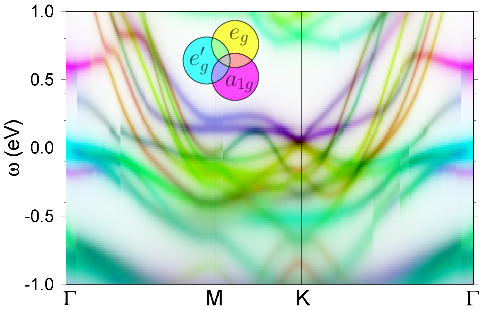ELEMENTARY PARTICLE PHYSICS
Multiorbital Instabilities in Quantum Materials (MIQS)
Principal Investigator:
Dr. Frank Lechermann
Affiliation:
Ruhr-Universität Bochum, Germany
Local Project ID:
chhh08
HPC Platform used:
JUWELS/JURECA at JSC
Date published:
The mutual Coulomb interaction between electrons in crystalline condensed matter systems gives rise to a plethora of fascinating physics. While the interaction between electrons and the nuclei is foremost important for the respective stable crystal structure that emerges for a given combination of elements, the character of the electronic many-body system that resides on such a periodic lattice governs the phenomenology of the material. For instance, if the electrons are free to move throughout the lattice, a metallic state results, well-known e.g. for aluminum or copper. If in addition the interplay between the electrons favors for some reason a common alignment of their individual magnetic moments (due to intrinsic „spin“ property of these elemental particles), a magnetically ordered state emerges, as e.g. for metallic and ferromagnetic iron. On the other hand, if the electrons are stuck in concrete bonds between lattice sites, an insulating or semiconducting state is established, as e.g. for diamond or galliumarsenide.
When the interaction between part of the electrons, depending on the combination of elements, becomes strong on a lattice, much more intriguing physics may take place. Electrons can become localized on a given lattice site and a new type of insulating state appears. Or the electrons can form pairs and enter a challenging superconducting states. Many more things, also in the interplay with the lattice degrees of freedom can happen in such highly complex materials, which physicists call „strongly correlated systems“. Our project aims specifically at the orbital degree of freedom of the electron (remember e.g. different orbital characters of hydrogen levels from your chemistry class) and its role in the realistic strongly correlated regime. Theoretically assessing this role is very demanding, since the sophisticated equations governing such interacting quantum many-body systems cannot be solved by hand exactly. Instead, a very heavy computational machinery in necessary to gain insight insight into the physics, and is here provided by the JUWELS cluster of the Juelich Supercomputing centre.
We focus on recently discovered superconducting nickel oxide compounds as well as layered ferromagnets composed of iron (Fe), germanium (Ge) and tellurium (Te). The latter systems are held together by weak so-called van der Waals forces, which renders exfoliation just as in graphite possible. Understanding the physical processes and mechanisms underlying superconducting nickelates and layered van der Waals ferromagnets will be important to design novel devices with exceptional transport and magnetic properties in the future. Such functional materials are becoming increasingly relevant to sustain a new stage in the industrial are, builduing up on energy efficient and „smart“ technologies. In the current project we were able to elucidate the distinct multiorbital nature of the nickelates from a theoretical perspective, which should lead to some kind of paradigm change for oxide based high-temperature superconductivity, that is so far dominated by effective single-orbital driven cupper oxide compounds. In the layered ferromagnet Fe3GeTe2 system we succeeded to reveal a so-called orbital-selective Mott transition, which basically means that one orbital part of Fe-based electrons undergo a transition toward localization in space, whereas the remaining electrons in other Fe orbitals are still free to move throughout the lattice. This very special electronic phase is extremely hard to find in materials and our work paves the way to new opportunities to study such challenging physics.

Figure: Electronic states of Fe2.9GeTe2 at room temperature in the so-called reciprocal space (appropriate for periodic lattice systems). The states appear as dispersions along high-symmetry lines, e.g. from M to K, in that space. The blurriness stems from the interaction among the electrons, tending to wash out the otherwise very sharp dispersion features. The color coding describes the different orbital character of Fe(3d) kind, i.e. either the dispersions carry one dominant orbital character from the three possible ones (denoted eg’, eg or a1g) or are associated with accordingly mixed orbital character.
Publications:
Emergent flat-band physics in d9−δ multilayer nickelates,
F. Lechermann, Phys. Rev. B 105, 155109 (2022).
Antiferromagnetic fluctuations and orbital-selective Mott transition in the van der Waals ferromagnet Fe3−xGeTe2,
X. Bai, F. Lechermann, Y. Liu, Y. Cheng, A. I. Kolesnikov, F. Ye, T. J. Williams, S. Chi, G. E. Granroth, A. F. May, S. Calder, Phys. Rev. B 106, L180409 (2022).